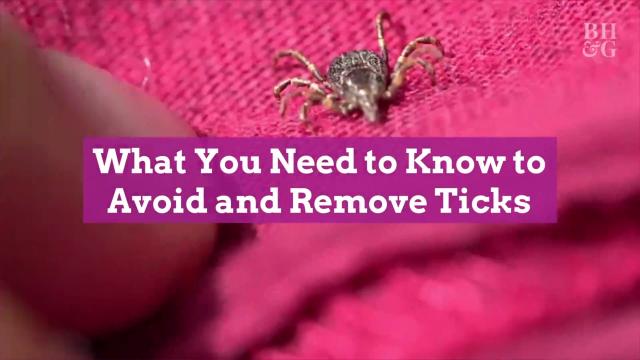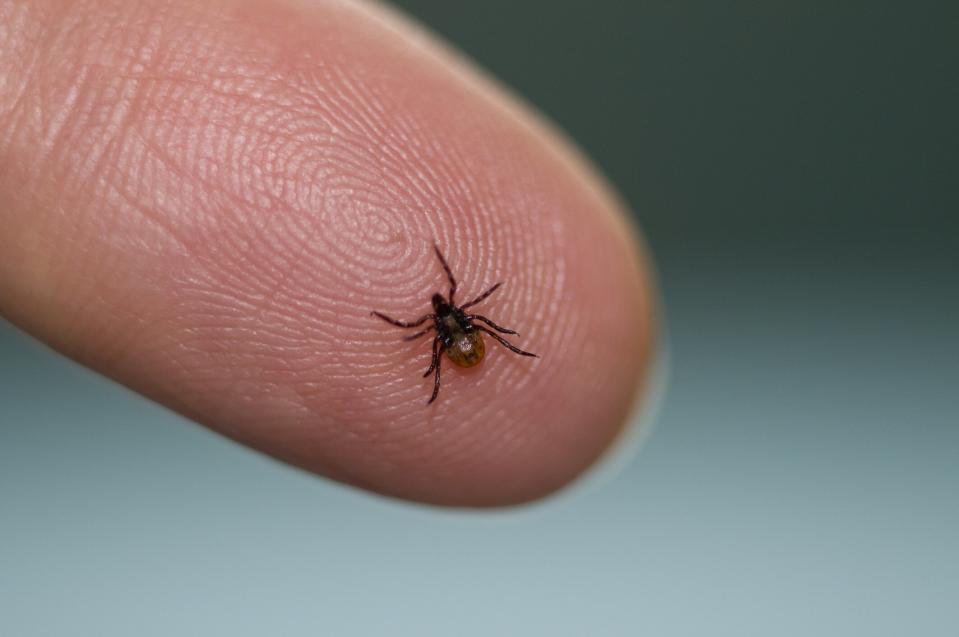What You Need to Know to Avoid and Remove Ticks

Warmer weather is finally here, but unfortunately, that means ticks are, too. Besides the ick factor of these little bloodsuckers, they also can spread some pretty serious illnesses like Lyme disease when they bite people and pets. That's why it's important to know which types of ticks are found in your area, and how to identify them so you know what to look for when you're coming back in from being outdoors. Repelling ticks is your best bet for staying safe, but if you do end up bringing home some unwelcome guests, don't panic! The best thing to do is properly remove a tick soon after it bites you. You'll also want to keep an eye out for any signs of illness afterwards. Here's what you need to know.

Lauree Feldman / Getty Images
All About Ticks (And How to Identify Them)
There are seven types of ticks present in the United States. The most notorious for spreading diseases are black-legged ticks (Ixodes) and the Rocky Mountain wood ticks. These members of the arachnid family are extremely small and can look like a birthmark or mole on your skin. Ticks live in grassy or wooded areas, or on animals when they attach to skin and feed on blood. They're often found on warmer areas of the body like the scalp, between the legs, and under the arms.
American Dog Tick
Found in areas east of the Rocky Mountains and along the Pacific Coast, American dog ticks can be less than ?-inch long (and despite their name, they'll bite both people and pets). They're brownish-red, shaped like long, flat ovals, and common in areas without many trees, including grassy fields, walkways, and trails.
Blacklegged (Deer) Tick
Only about 1/8-inch long, reddish-brown in color, and found in the Northeast, mid-Atlantic, and upper Midwest regions. They tend to live in forested areas and often hitch rides on white-tailed deer, but will also bite a passing human.
Lone Star Tick
Common in the Southeast and eastern states, lone star ticks are brown and about 1/8-inch long. The females have a white spot on their backs that gives them their name. Usually, these ticks live in wooded, overgrown areas.
Rocky Mountain Wood Tick
Slightly larger than other species, Rocky Mountain wood ticks can be 1/4- to 1/2-inch long, and are dark brown with gray or cream markings. They're found in the Western half of the U.S. in lightly wooded areas, grassy fields, and along walkways and trails.
Longhorned Tick
First spotted in the U.S. in 2017, the longhorned tick is usually found in Australia, New Zealand, and eastern Asia. Usually less than 1/4-inch long and reddish-brown in color, this tick has been documented in Arkansas, Connecticut, Delaware, Kentucky, Maryland, North Carolina, New Jersey, New York, Pennsylvania, Tennessee, Virginia, and West Virginia. According to the CDC, longhorned ticks seem to be less attracted to human skin than native tick species, but they've been known to spread disease in other parts of the world.
Preventing Ticks
The best way to keep yourself and your pets safe is to prevent ticks from crawling on you in the first place. They can't jump or fly, but if you brush against plants outside, they can crawl right onto you.
On People
A tick can climb on you any time you're outside, even in your own neighborhood (so don't make the mistake of thinking they only live in the woods). To try and prevent them, apply a repellent whenever you're going outside; put it on after your sunscreen, and double-check the label so you'll know how long it lasts. Choose a repellent with a 20-30% DEET concentration (any higher won't offer you much extra protection). Picaradin works almost as well, and a 20% solution will protect you for up to 14 hours. If you want something more natural, oil of lemon eucalyptus will work for up to two hours.
It also helps to wear long pants tucked into socks and a long-sleeved shirt tucked into your pants when you go outside. Spraying permethrin, another type of repellent, on your clothes, shoes, and socks can also help prevent ticks. When you get home, take off your clothes right away and run them through a hot dryer for 10 minutes to kill any ticks that hitched a ride. If you can, shower within two hours of coming inside, and give yourself a thorough tick-check.

Getty Images
On Pets
Dogs and cats can also be bitten by ticks and infected with illnesses. Ask your vet about tick prevention products like collars, salves, and medicines to keep your pet tick-free. Check all pets for ticks, especially after they spend time outdoors. While outdoor cats can also get ticks, they're much more sensitive to certain chemicals often found in tick-preventative products. Ask your vet before applying any products on a cat.
In the Yard
Pesticides can reduce the number of ticks in your yard, but shouldn't be the only preventative method you use. You can reduce black-legged ticks in your yard with landscaping techniques. Remove leaf litter and tall grasses where ticks tend to live. Mowing frequently also helps (keeping your grass less than 3 inches tall is ideal). The CDC recommends placing a 3-foot-wide barrier of wood chips or rocks between lawns and wooded areas to restrict tick migration to living spaces. Because ticks can live on animals like deer, raccoons, and strays, consider adding a fence to keep unwelcome animals out. You can also try spreading tick tubes around your yard; they have permethrin-soaked cotton, which mice take for their nests, and the permethrin will kill tick nymphs without harming the mice that they live on.
Removing Ticks
The key to avoiding tick-borne diseases is to remove them as soon as possible. The CDC says that if you remove a tick within 24 hours, you'll significantly lower your chances of getting Lyme disease. There are many “home remedies” that make ticks detach from the skin, like painting the tick with nail polish or petroleum jelly, or using heat to make the tick back out from being burrowed into skin. While these methods may work, the CDC says “Your goal is to remove the tick as quickly as possible, not wait for it to detach.”
Their recommended method is using a plain set of fine-tipped tweezers. Use the tweezers to grab the tick as close to the surface of the skin as you can, then pull upward with steady, even pressure. Don't pull too fast or twist the ticks; they burrow their mouths into the skin, and being too aggressive can break off the mouth parts, leaving them in the skin. After removing the tick, clean the bite and your hands with rubbing alcohol or soap and water.
You also need to dispose of the tick methodically. Never crush a tick with your fingers; they can survive being hit with a hammer, so crushing them won't work. Instead, put it in alcohol or place it in a sealed bag or container. This will preserve the tick just in case you need to have it tested for diseases.
Diseases and Symptoms
Unless you spot a tick on you, you might not realize you've been bitten. Ticks can spread a number of diseases, the most common being Lyme disease, Rocky Mountain spotted fever (RMSF), and anaplasmosis. A single tick bite can spread multiple diseases at once, and symptoms of these diseases may not appear until days after a tick bite. The most common symptoms of tick-borne diseases are fever, muscle aches, rash, headache, and joint pain, without a stuffy nose or cough.
Lyme disease is famous for causing a bull's eye-like rash, but not every case of Lyme disease presents a rash. RMSF can cause someone to develop a pink rash that starts on wrists, forearms, and ankles before spreading to the torso. If you experience any of these symptoms after a tick bite, see a doctor immediately, and be sure to tell them where you've been (such as active in your garden or woods around your home); this can help them diagnose you. Paralysis, while rare, is also possible, and should be addressed immediately.